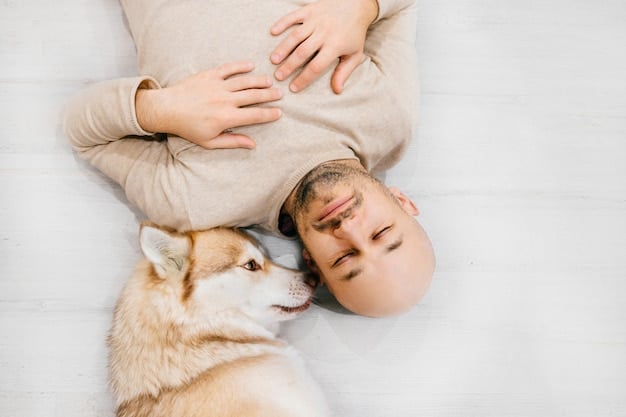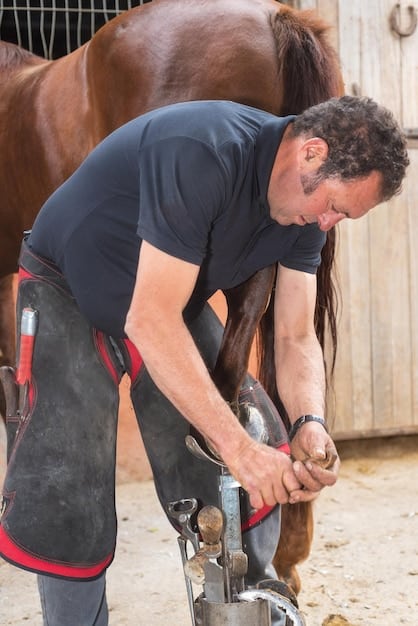Pet Massage: Benefits for Relaxation and Tension Relief

Anúncios
Pet massage offers numerous benefits, including reducing muscle tension, promoting relaxation, improving circulation, and enhancing the overall well-being of your beloved animal companion.
Discover the incredible benefits of pet massage: relieving tension and promoting relaxation for your furry friends, enhancing their overall health and happiness.
Anúncios
Understanding the Basics of Pet Massage
Pet massage, like human massage, involves the manipulation of soft tissues to promote relaxation and well-being. It’s a therapeutic practice that can be adapted to suit various animals, from dogs and cats to horses and rabbits.
This practice is not just about pampering your pet; it’s about providing genuine health benefits that can improve their quality of life. When performed correctly, pet massage can be a powerful tool in maintaining your animal’s physical and emotional health.
Anúncios
What is Pet Massage?
Pet massage involves using different techniques to manipulate the muscles, tendons, and ligaments of an animal. The goal is to release tension, increase circulation, and promote a sense of calm. It’s a hands-on approach that requires understanding of animal anatomy and behavior.
Benefits Beyond Relaxation
While relaxation is a primary benefit, pet massage offers much more. It can help with pain management, improve joint mobility, and even speed up recovery from injuries or surgeries. Regular massage can also strengthen the bond between you and your pet.
- Reduce anxiety and stress in pets
- Improve blood circulation
- Provides comfort to aging pets, especially those with arthritis
- Assist in recovery post-surgery
In conclusion, pet massage is more than just a feel-good activity. It’s a therapeutic practice that can provide numerous health benefits, from reducing anxiety to improving physical function. By understanding the basics, you can begin to incorporate this practice into your pet’s routine, enhancing their overall well-being.

Relieving Tension in Pets Through Massage
Tension in pets can manifest in various ways, from behavioral changes to physical symptoms like stiffness and muscle knots. Identifying these signs is crucial for addressing the issue effectively. Massage offers a direct way to release this tension, promoting a sense of calm and well-being.
Pets can experience tension due to various factors, including anxiety, fear, and physical discomfort. Recognizing these sources of tension allows you to tailor your massage techniques to provide the most effective relief.
Recognizing Signs of Tension
Pets often exhibit subtle signs when they are tense. These can include changes in posture, such as a hunched back or tucked tail, as well as behavioral changes like excessive licking, panting, or restlessness. Some pets might also become withdrawn or irritable.
Massage Techniques for Tension Relief
Specific massage techniques can target areas of tension in your pet’s body. Gentle strokes along the back and shoulders can help release muscle knots, while circular motions can improve circulation and ease stiffness. Always pay attention to your pet’s response and adjust your pressure and technique accordingly.
- Use gentle pressure
- Focus on the back and shoulders
- Pay attention to reactions and adjust pressure based on comfort
- Maintain a calm and steady rhythm
In conclusion, relieving tension in pets through massage requires both understanding the signs of tension and applying appropriate massage techniques. By being attentive and responsive to your pet’s needs, you can provide significant relief and improve their overall quality of life.
Promoting Relaxation Through Pet Massage
Relaxation is one of the most immediate and noticeable benefits of pet massage. When pets are relaxed, they are less likely to exhibit anxiety or stress-related behaviors, leading to a happier and healthier life. Regular massage can help maintain this state of calm and well-being.
Massage helps to calm the nervous system, reducing heart rate and promoting the release of endorphins. This can create a sense of peace and tranquility, making your pet more receptive to training, socialization, and other positive experiences.
The Physiological Effects of Relaxation
Massage stimulates the parasympathetic nervous system, which is responsible for the “rest and digest” response. This leads to a decrease in heart rate, blood pressure, and cortisol levels, all of which contribute to a state of relaxation.
Creating a Relaxing Environment
The environment in which you massage your pet can greatly influence their ability to relax. Choose a quiet, comfortable space where they feel safe and secure. Soft lighting, soothing music, and familiar scents can further enhance the relaxation experience.
- Choose a quiet, comfortable space
- Use soft lighting and calming music
- Incorporate familiar scents
- Speak in a gentle, soothing voice
In summary, promoting relaxation through pet massage involves creating the right environment, understanding the physiological effects of massage, and being attuned to your pet’s needs. By incorporating these elements, you can provide a deeply relaxing experience that enhances their overall well-being.
Improving Circulation with Pet Massage
Improved circulation is a key benefit of pet massage, contributing to overall health and vitality. Enhanced blood flow helps deliver oxygen and nutrients to cells, while also removing waste products. This can lead to better organ function, improved immune response, and faster healing.
Poor circulation can manifest in various ways, from cold extremities to slow wound healing. Massage provides a direct way to stimulate blood flow, addressing these issues and promoting overall health. Incorporating massage into your pet’s routine can have significant long-term benefits.
How Massage Enhances Blood Flow
Massage techniques, such as kneading and stroking, help to dilate blood vessels, allowing for increased blood flow. This, in turn, improves the delivery of oxygen and nutrients to tissues and organs. Regular massage can help maintain optimal circulatory function.
Practical Techniques for Circulation
Specific massage techniques are particularly effective for improving circulation. Gentle, rhythmic stroking along the limbs and torso can help to stimulate blood flow, while circular motions can target specific areas of congestion or stiffness. Always be mindful of your pet’s comfort and adjust your technique accordingly.

- Stroking motions on the legs
- Circular motions around joints
- Gentle kneading of larger muscle groups
- Consistent rhythm and pressure
In conclusion, improving circulation with pet massage involves understanding how massage enhances blood flow and applying practical techniques to stimulate circulation. By incorporating these practices into your pet’s routine, you can promote better health and vitality.
The Role of Pet Massage in Pain Management
Pain management is a significant aspect of pet massage, particularly for animals suffering from chronic conditions like arthritis or recovering from injuries. Massage can help alleviate pain by releasing endorphins, reducing inflammation, and improving joint mobility. It’s a holistic approach that complements traditional medical treatments.
Pets often hide their pain, making it challenging to identify when they’re suffering. Massage provides a way to assess their comfort levels and address areas of sensitivity. Regular massage can improve their quality of life and reduce their reliance on pain medication.
Understanding Pain Signals
Recognizing pain signals in pets is crucial for effective pain management. These can include changes in behavior, such as decreased activity levels, reluctance to move, or aggression. Physical signs like limping, stiffness, and sensitivity to touch can also indicate pain.
Massage Techniques for Pain Relief
Specific massage techniques can provide targeted pain relief. Gentle effleurage (stroking) can help to soothe sore muscles, while petrissage (kneading) can release muscle knots and improve circulation. Always be gentle and patient, and avoid applying pressure directly to painful areas.
- Gentle strokes to soothe sore muscles
- Kneading to release muscle knots
- Targeted pressure relief
- Consistency and patience
In summary, pet massage plays a vital role in pain management by helping to alleviate pain, improve mobility, and enhance overall well-being. By understanding pain signals and using appropriate massage techniques, you can provide significant relief for your pet.
Bonding with Your Pet Through Massage
Strengthening the bond with your pet is a wonderful side effect of massage. As you provide comfort and relief, your pet learns to trust and rely on you. This can deepen your connection and enhance your relationship. Regular massage sessions can become a special time for both of you.
Massage involves physical touch, which releases oxytocin, often referred to as the “love hormone.” This hormone promotes feelings of bonding and attachment. By incorporating massage into your routine, you can strengthen the emotional connection with your pet.
Creating a Positive Experience
To maximize the bonding experience, it’s important to create a positive and comfortable environment. Choose a time when your pet is relaxed and receptive, and avoid any distractions. Speak in a gentle, soothing voice, and offer praise and encouragement throughout the massage.
Reading Your Pet’s Body Language
Pay close attention to your pet’s body language during the massage. If they seem uncomfortable or resistant, adjust your pressure or technique. If they seem to be enjoying it, continue with gentle, rhythmic strokes. By being attuned to their needs, you can create a mutually beneficial experience.
- Speak in a gentle and soothing voice
- Offer praise and encouragement
- Stop if the pet seems uncomfortable
- End on a positive note
In conclusion, bonding with your pet through massage involves creating a positive experience, being attuned to their body language, and understanding the emotional connection that massage promotes. By incorporating these elements, you can strengthen your bond and enhance your relationship with your pet.
Precautions and Safety Tips for Pet Massage
While pet massage is generally safe, it’s important to take certain precautions to avoid causing harm. Understanding contraindications, such as infections or injuries, and following basic safety tips can ensure a positive and effective massage experience. Always consult with a veterinarian if you have any concerns.
Certain conditions may make massage unsafe for your pet. For example, pets with open wounds, infections, or certain medical conditions should not be massaged. It’s also important to avoid applying pressure to areas that are tender or inflamed.
When to Avoid Massage
Avoid massaging pets with the following conditions: open wounds, skin infections, fever, contagious diseases (to prevent spread). Also, refrain from massaging directly over surgical sites until fully healed.
General Safety Guidelines
Always use gentle pressure and observe your pet’s cues. Sudden winces, attempts to move away, or signs of distress indicate discomfort, necessitating immediate gentle cessation of touch and a reassessment of the area. Adapt pressure accordingly.
- Avoid direct pressure on wounds
- Use gentle techniques
- Always monitor your pet’s reaction during massage. If the pet winces, pants, or tries to move away, stop and try again later.
- Be aware of any underlying health conditions or injuries your pet may have. If your pet has any health conditions or injuries, consult with your veterinarian before performing pet massage.
In summary, ensuring the benefits of pet massage: relieving tension and promoting relaxation effectively requires heeding all necessary precautions and familiarizing oneself with essential precautions. Consult a veterinarian before performing pet massage could significantly contribute to its effects, preventing potential damage and enhancing overall wellbeing.
| Key Point | Brief Description |
|---|---|
| 🐾 Tension Relief | Reduces muscle tension and promotes relaxation. |
| ❤️ Bonding | Strengthens the bond between you and your pet. |
| 🩸 Circulation | Improves blood circulation and overall health. |
| 😌 Relaxation | Promotes relaxation and reduces stress. |
Frequently Asked Questions
▼
Pet massage helps to relieve tension, promote relaxation, improve circulation, and strengthen the bond between you and your pet, enhancing their overall well-being.
▼
The frequency of massage depends on your pet’s needs. Generally, massaging your pet two to three times a week for 10-15 minutes can provide significant benefits. Adjust based on their comfort level.
▼
Avoid massaging your pet if they have open wounds, skin infections, fever, or contagious diseases. Also, consult with your veterinarian before massaging if your pet has underlying health conditions.
▼
Pet massage is generally safe for most pets, but it’s important to consider individual needs and health conditions. Consult with a vet before trying massage on geriatric or pregnant animals to ensure safety.
▼
Signs that your pet is enjoying the massage include relaxed body posture, soft eyes, gentle purring or sighing, and leaning into your touch. Pay attention to these cues to ensure a positive experience.
Conclusion
In summary, pet massage offers a multitude of benefits for relieving tension and promoting relaxation in your beloved companions. By understanding the techniques and precautions, you can provide a valuable service that enhances their physical and emotional well-being, strengthening your bond in the process.






